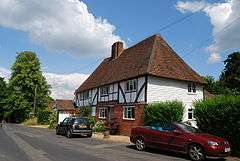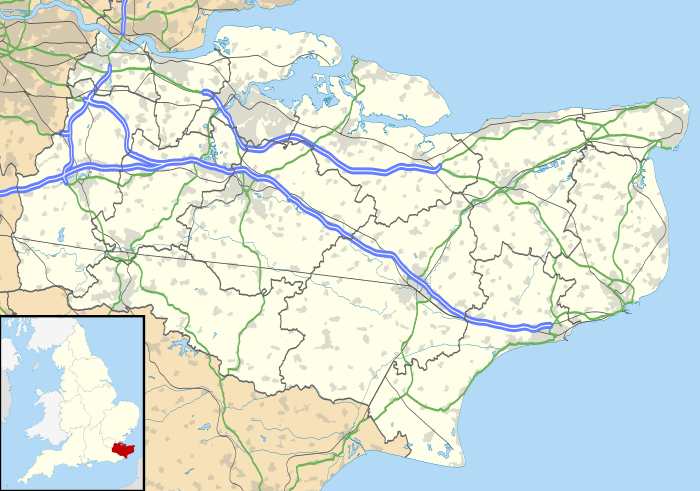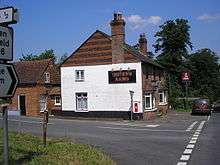Cowden
Cowden (/kaʊˈdɛn/) is a small village and civil parish in the Sevenoaks District of Kent, England. The parish is located on the northern slopes of the Weald, south-west of Tonbridge. The old High Street has Grade II listed cottages and village houses, and there is an inn called The Fountain. At the 2011 Census the population of the village was 818.[1]
| Cowden | |
|---|---|
 A cottage on the High Street | |
 Cowden Location within Kent | |
| Population | 818 (2011 Census)[1] |
| District |
|
| Shire county | |
| Region | |
| Country | England |
| Sovereign state | United Kingdom |
| Post town | Edenbridge |
| Postcode district | TN8 |
| Police | Kent |
| Fire | Kent |
| Ambulance | South East Coast |
| UK Parliament | |
History
The Romans built the London to Lewes Way across what is now the garden of Waystrode Manor. The first owners of the manor received it from King John in 1208.
Crippenden Manor, built in about 1607, was once the home of ironmaster, Richard Tichborne (1568-1639), related to the Tichbornes of Tichborne, Hampshire. This branch of the Tichbornes descended from a younger son of John Tichborne and Margaret Martin, who inherited his mother's lands in and around Edenbridge, including Crippenden. Richard was the son of John Tichborne (c1549-1620) and Dorothy Chaloner, daughter of Thomas Chaloner of Lyndfield and his wife, Alice Shirley. Richard married Dorothy Saxbie, circa 1592, and had at least ten children, including Dorothy who married John Tillinghast (1604–55), son of the Rector of Streat, who was also involved in the iron industry. Richard formally leased Crippenden from 1612 and built the house there. It descended to Captain Edmund Tichborne who sold the manor after 1721.
The village appears as Cudena in Textus Roffensis.[2]
In 1649 Robert Tichborne, a nephew of Richard Tichborne, petitioned the House of Commons in favour of the execution of Charles I. He was one of the Commissioners who, in 1651, prepared the way for the union with Scotland; he was knighted in 1655 by Cromwell, and was elevated to the peerage in 1657. After the Restoration of the monarchy in 1660, he was arrested and sentenced to death, but was reprieved, imprisoned in Dover Castle and died, in 1682, in the Tower of London. The family, however, did not die out in Cowden until 1708, when the last member of the family, John Tichbourne, was buried there.
This is old Wealden iron country, recalled by the cast iron memorial slab in the church, to John Bottinge, dated 1622. This was a time when the area was producing guns for the Army and Navy, as well as domestic and agricultural ware. Cowden had its own blast furnace from 1573 until sometime in the 18th century. The rumoured second 'upper' Cowden Furnace is now known to have been Scarlets Furnace nearby is on the Kent side of the stream and the three counties actually meet between old Basings house and Smithers Farm.[3]
Demographics
Predominantly white English. Mainly Christians and atheists.
Church
The ancient parish church is dedicated to St Mary Magdalene, and has a restored shingle covered spire.
Parts of the parish straddle the Kent Water which forms the border with East Sussex and Surrey where the three counties meet.
It is centred on a 13th-century church of St Mary Magdalene with its slender, wooden shingled spire, bomb-damaged during World War II and since re-shingled. The spire is barely perceptibly out of perpendicular, which gave rise to a rhyme:[4]
Cowden church, crooked steeple, Lying priest, deceitful people.
The church is built of sandstone, its tower and steeple timber-framed inside. The old bells were recast and rehung in 1911 to commemorate the reign of Edward VII and a sixth bell was added at the Coronation of George V.
A stained glass window given to the church in 1947, celebrates 'the remarkable preservation of this village during the years 1939-45' and features figures of St Bridget (representing the women of the parish), St Nicholas (for the sailors), St George (the soldiers and airmen), and St Mary Magdalene, all the company of Sir Walstan (the farmer bishop of Worcester Wulfstan (1062–95) representing the local farmers). Below them are 20th-century figures: a sailor, soldier, airman, a nurse, and others making up a representative group of people involved in World War II, all turned towards a Christ-figure whose protection they seek.
The Queen's Arms

The Queen's Arms is a mid 19th century Grade II listed public house at Hartfield Road.[5] It is on the Campaign for Real Ale's National Inventory of Historic Pub Interiors.[6]
Transport
Its railway station was the scene of a fatal crash in 1994. There is a regular service to London and Uckfield.
Notable residents
Neil Trotter and partner Nicky Ottoway, who won £108 Million in the euromillions purchased a £5 million property with eight bedrooms overlooking vast woodland and fields with its own lake in Cowden, following their win. The traditional mansion is also home to Neil’s fleet of Supercars. An attempted break in was reported to the property by a balaclava gang in the months following the purchase of the house, surprising many as Cowden was known as an area with a low crime rate.
English author and actress Clemence Dane (Winifred Ashton) wrote part of her novel The Arrogant History of White Ben in Cowden, signing the book Cowden 1938 at the end of the tale.[7]
Brigadier Ralph Bagnold, OBE, FRS, desert explorer and the founder and first leader of the Long Range Desert Group, lived at Rickwoods, just outside Cowden, between 1949 and 1983. A world expert on the movement of sand by natural means, he worked with NASA on the movement of sand on Mars, as a result of which a sandy area of that planet is now known as 'The Bagnold Dunes'.
The English author and illustrator of children's books, Roger Hargreaves, best known as the creator of the Mr Men and Little Miss series of books, lived at Sussex House Farm in Hartfield Road from 1982 to 1988. He is buried in the graveyard of the parish church, in an extension of land which he had donated the year before his death.
The English actor Sir John Mills lived in Cowden for several years.
References
- "Civil Parish population 2011". Neighbourhood Statistics. Office for National Statistics. Retrieved 18 September 2016.
- Edward Hasted (1797). "The History and Topographical Survey of the County of Kent: Volume 3". pp. 203–210.
- Pearce, H, Hammer and Furnace Ponds, Pomegranate Press (2011)
- "St Mary Magdalene, Cowden". Church of England.
- Historic England, "Queen's Arms, Cowden Pound (1387747)", National Heritage List for England, retrieved 20 August 2014
- Brandwood, Geoff (2013). Britain's best real heritage pubs. St. Albans: CAMRA. p. 50. ISBN 9781852493042.
- Clemence Dane, The Arrogant History of White Ben London, William Heinemann 1939
External links
| Wikimedia Commons has media related to Cowden. |
- Cowden Village Website HomePage
- Kent Parish Councils Cowden HomePage
- The Weald Of Kent, Town History
- Cowden Pound Pastures
- Cowden Conservation Society
- Multimap
- The Fountain Inn, Cowden
- Cowden Furnace Pond
